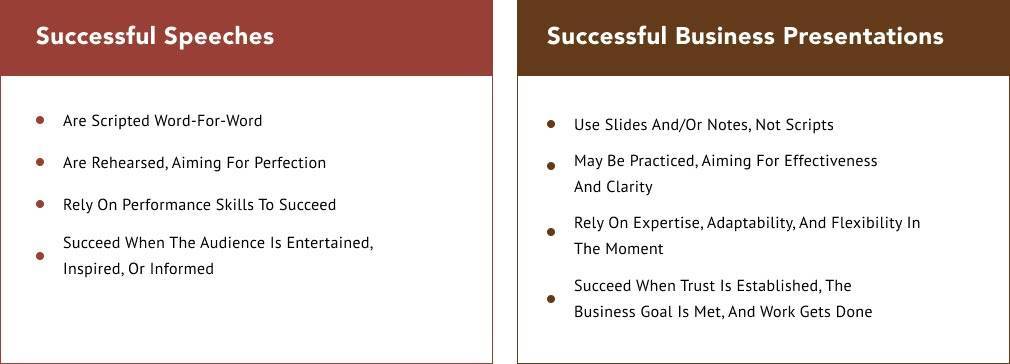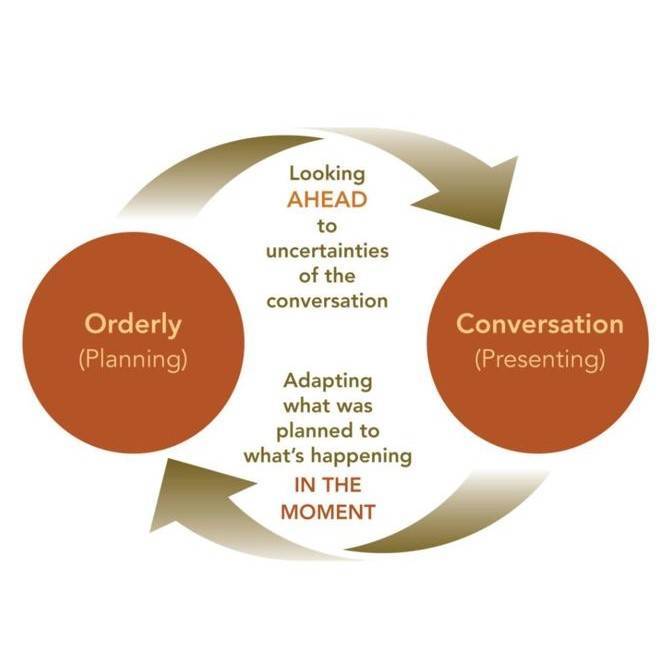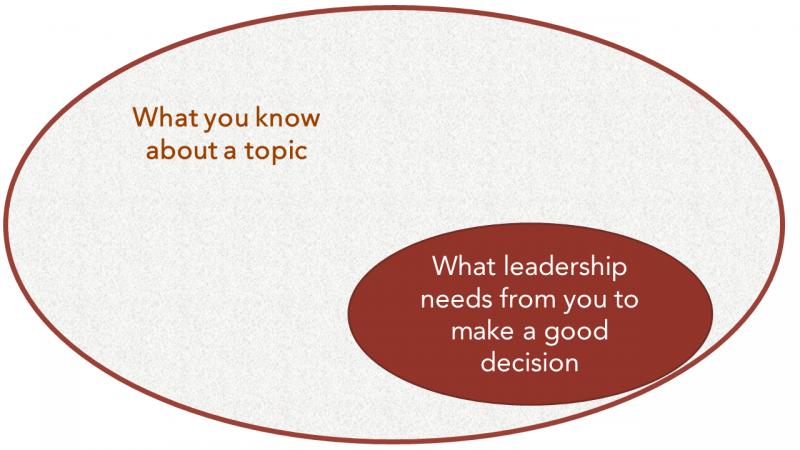Presentations, whether they are face-to-face, virtual, or a hybrid of the two, are a part of everyday business life. Many people think their presentations need to be perfect. What they really need to be, though, is effective and efficient. They need to get business done.
Our goal with this guide is to help you be more effective and efficient at preparing and delivering successful presentations through our proven methods and unique approach. We will equip you with the skills and guidance you need to apply them to your specific circumstances.
- First, we’ll clear the slate, acknowledging frustrations you may be facing, untangling old advice that’s distracting rather than helpful, and addressing common questions and assumptions.
- Next, we’ll establish a clear pathway to effective business presentations based on our thirty years of experience in a range of industries and at all corporate levels, from the maintenance department through the C-suite.
As you travel this pathway, you’ll probably discover some habits you’ll have to unlearn. But, if you’re like many others we have worked with, you’ll also discover that you’re already doing well in some areas. What we’ll do together is grow your self-awareness and hone your skills through simple, practical techniques and strategies you can continue to apply and refine throughout your career.
A Note for Managers and Learning & Development Professionals
Your goal is to facilitate the professional growth of the employees in your organization, and you want to ensure you are getting the best value across the board—for your employees, the individuals they serve, and your company’s bottom line. Our goal is to help you do that using a method with a solid track record that is adaptable to your unique needs and has documented client satisfaction.
Delivering a presentation should be no more challenging than any other part of an employee’s job. However, as you know, “soft skills” are considered a major deficit in the current workforce, so individuals and companies that can deliver on them consistently are singled out for success. The goal here is to help you achieve that for your company. Our method starts with a shift in mindset that redefines presentations as Orderly Conversations®. This shift includes how to analyze the audience for a specific presentation and touches on factors as large as managing group dynamics and as specific as helping an individual work through a bad presentation experience in their past.
The issues addressed on this page are common to presenters at all levels and across industries. As you will see, this information is practical not only in the methods we recommend but also in how relatively straightforward they are to learn, practice, and implement. Your employees want and need to be preparing and delivering business presentations as effectively as they do the rest of their work.
Let us help with that.
Let’s get the conversation started.
Improving Presentation Skills: What It Means For You
The first thing to acknowledge is that your path to improvement is unique to you. This is true for a number of reasons. Your history as a presenter has equipped you with your own preferences and habits that may not even be fully intentional—or as effective as they could be. Previous speech classes or presentation training may have instilled some counterproductive beliefs.
Your history as a presenter has equipped you with your own preferences, habits, and counterproductive beliefs that may not even be fully intentional. Your path to improvement is unique to you.
Your current role may require emphasis on specific skills, such as delivering dense data or making a persuasive sales pitch. Nervousness also plays a big role in how individuals feel about presentations, as does your tendency to over or under-prepare for the presentations you deliver.
To see what we mean, think about how you prepared for and delivered presentations at the start of your career compared with now. Or think about the best presenter in your company or industry. They weren’t always like that. Time, confidence, and experience have made them that way.
Our goal is to help you improve quickly and efficiently. That begins by redefining what a “business presentation” actually is. It’s certainly not a speech, although you may have been taught to treat it that way. We think of a business presentation as an Orderly Conversation—an efficient, interactive delivery of information and effective management of the give-and-take that’s a part of it.
As you explore the recommendations in this guide, think about your particular needs and responsibilities. We aim to keep our guidelines flexible and customizable. The goal is that no matter what your industry is or where you are in your career, you can implement our method quickly and easily and focus on the meaningful work you do.
Three Guiding Principles of Effective Business Presentations
Three principles are foundational to improving your presentation skills, and everything else you will learn is based on them. All by themselves, these three ideas will shift your perspective on business presentations and establish a new standard for what makes an effective one.
1. Business Presentations Are Orderly Conversations, Not Speeches
The first thing to clarify is that there are some big differences between a successful business presentation and a successful speech. In school, you learned how to give speeches—a thing you probably rarely have to do now. Business presentations require a different set of skills, and their success is measured in different ways.

We defined business presentations as Orderly Conversations because —
- They need to be planned and organized in advance with a clear understanding of goals.
- At the same time, they are conversations because they take place in a spontaneous, interactive environment where the effectiveness of the presentation is enhanced by participation from listeners.
The term Orderly Conversation doesn’t just apply to occasions labeled as “business presentations.” It also includes meetings, training sessions, sales presentations, and high-stakes one-on-one conversations. Any time you have to share information or explore a topic with a specific goal in mind can be thought of as an Orderly Conversation.

2. Find Your Focus. Be Yourself. Only Better.
The second guiding principle is that as a business presenter, you should “Find Your Focus. Be Yourself. Only Better.” This means that you can and should bring your genuine personality into your presentation. You are at the front of the room because you are an expert on your information. That is the part of you your audience came to hear, and it is no different from a meeting or a phone call in terms of who you are supposed to be.
Once you have the skills to be comfortably yourself in front of an audience, your presentations will not only get easier to prepare and deliver, they’ll become more effective and maybe even enjoyable. Everything from creating a PowerPoint deck that works for you to managing the twists and turns of interaction with your listeners will feel more intuitive and powerful.
3. Presentations Succeed on Two Levels
Our third principle relates to the idea that as a presenter, you have two levels to manage, and the success of the first one depends on your management of the second. Here is what we mean:
- The first level is about meeting your business goal: making the sale, delivering the information, or moving the project forward, for example.
- The second level is about managing the process and creating the conditions for a fruitful exchange of ideas. If you give this level the right amount of focused attention, you are more likely to achieve your business goal. If you neglect it, a lot of elements become more difficult: establishing your listeners’ trust, managing your nervousness, and getting business done.
Once you acclimate to these three guiding principles, you’ll find that preparing and delivering a successful presentation becomes more efficient and pleasant and is less of a burden on your time and resources.
Presentation Fundamentals
Preparing for a Presentation
Often, preparing a presentation feels like wading into the weeds. There is a tangle of information you need to deliver, uncertainty about your audience and the environment, and perhaps a dash of nervous panic.
To improve your presentation skills, your preparation should focus on keeping the conversations orderly, communicating relevancy, and keeping yourself on track during presentation delivery.
When preparing for an Orderly Conversation, preparation should focus on three goals:
- Keeping the conversation orderly
- Communicating relevance and efficiency to listeners
- Keeping yourself focused and on track during delivery
To reach these goals, pay attention to these core elements of preparation that are often neglected or used ineffectively:
- Analyze the audience and the business goal; think about the information you want to use or convey and what you want your listeners to do or think at the end of your presentation. Consider how much they know and care about your goal and anticipate any resistance they might have to it.
- Decide on a listener-focused and flexible organizational structure, including an introduction that begins to build your audience’s trust in you.
- Find a way to practice your presentation that builds your confidence before you present—aiming to be effective, not perfect.

Presentation Introductions
The way you begin your presentation is the first step in establishing your authority, gaining your audience’s trust, and raising expectations that good work will get done. There are a lot of questionable tips and tricks out there from “begin with a joke” to “skip the agenda.” What you’ll learn here is how to speak to your audience’s needs immediately and begin the process of a fruitful Orderly Conversation.
“Framing the conversation” at the beginning not only helps you establish credibility with your audience but also helps you stay on track during the presentation delivery.
If you begin by communicating the following four ideas quickly, you give your audience reason to believe you know what you’re doing and you are going to use their time efficiently:
- The direction you’re heading
- The purpose of the presentation
- The business context and how your content fits within it
- A meaningful reason for them to participate in the conversation
We call this “framing the conversation.” A solid frame not only helps you establish credibility with your audience but also helps you stay on track during the preparation process and when you deliver the information your listeners need.
Framing Your Presentation Helps Set Context
Once you’ve considered your audience and how you plan to deliver information, think about how you will begin the presentation. An agenda is vital, but you also want to set context, clearly state your goal, and articulate the audience takeaways from the presentation. Your goal is to frame the conversation by providing a sense of direction, purpose, and a reason for your audience to participate.
Slide Design Best Practices
There’s no such thing as the PowerPoint police, and a lot of longstanding rules of slide design are simply not practical in a fast-paced business environment. With a few reasonable and flexible guidelines, you can create a slide deck that supports effective, confident delivery and helps you manage an effective and efficient Orderly Conversation.
Let’s start with some slide design recommendations:
Once you’ve identified the information that is critical to your audience, your next goal is to frame the conversation by providing a sense of direction, purpose, and a reason for them to participate.
- Every aspect of your slide should be useful to the purpose of your presentation and to your audience’s understanding of your material. Think about how your slide layouts, slide titles, and transitions serve your overall goal.
- There are no prizes for delivering the most information with the fewest slides. Give each major thought room to breathe on its own slide. This will help you when delivering slides and prevent confusion for your audience.
- Your slides should help you with delivery, not get in your way. As you craft your PowerPoint deck, check in with each slide to be sure you can identify its main point and speak to all the elements on it with relative ease. If it is easy for you to deliver, it will be much easier for your audience to take in.
- If your presentation is going to be virtual, add slide animations on busy slides so that you can control where folks look. Doing so will make it impossible for listeners to read ahead.
Slide Delivery Best Practices
One of our mottoes is “make it easy.” This means that a presentation should be easy for you to prepare and deliver and for your audience to take in, process, and work with. During the delivery of your presentation, you make things easy by directing focus to and from your slides. Whenever you’re delivering slides, it is essential that your audience knows where you want them to look, what they’re looking at, and why it’s significant.
A few techniques that are easy to implement can be an enormous help in delivering clear information that’s easy to follow:
- Point to the visual on the screen or monitor that you want your audience to focus on.
- Walk to the other side of the screen to draw attention to what’s there and signal a new point or topic.
- Use directional language to bring attention to a specific element, such as “as you can see in the green bar,” or “on the lower right side of the graph,” or “turning to slide seven…” This is particularly important in virtual presentations.
This approach will help you deliver your slides naturally, easily, and with great impact.
We know that you don’t always have control over your slides—for example, when your manager requires everyone to use the same clunky template or when showing an entire spreadsheet is essential—but you can make any slide work for you if you put care into its delivery.
Managing Presentation Nervousness
When simply hearing the word “presentation,” many people immediately feel nervous – the physical responses associated with speaking in front of people include things such as dry mouth, tension, rapid heartbeat. Nervousness with public speaking is an individual experience with many causes and many possible responses, from overpreparing or procrastinating to racing thoughts and self-doubt. For some, extreme nervousness about speaking in front of people may even stall their careers.

We don’t have a quick fix (and be wary of anyone who says they do), but we can help you deal with nervousness from public speaking by understanding what sparks it for you and what skills and techniques help you manage it. Over time, your distracting self-consciousness will turn into useful self-awareness. Rather than being scared of your audience, you may even connect with them in ways that dissipate your anxieties, build trust, and get good work done.
Engagement—The Key to Effective Presentations
You’ve created clear, deliverable slides, you know your material, and you have prepared to be comfortable and flexible while delivering your content.
All those elements are important, but there’s another major aspect of a successful presentation that happens with the audience: engagement. You must be fully engaged in order to connect with your audience and maintain control over the conversation you are leading.
When you are engaged, you are in the moment and in sync with your audience. You make eye contact and are aware of your body language throughout your presentation. You are less focused on your words and not afraid of questions that could take you “off-script.”
- Are mindful of what’s in their heads, focused on who is in front of them, and aware of what those individuals require.
- Think on their feet, are self-aware, and recover from stumbles with grace and humor.
The important thing to remember is that when you’re focused on the right skills, engagement is natural and effective.
An important aspect of a successful presentation is audience engagement. You must be fully engaged in order to connect with your audience and lead your presentation.
Avoiding Information Overload
If you are in a data-heavy role—research, IT, finance—you may struggle with delivering your analysis or findings to individuals outside your area of expertise. Think of it this way: the main points your audience needs in order to do their work is a small, specific subset of what you know about the topic. Your job is to decide what is essential for them and how to communicate it effectively.
There are two ideas to keep in mind:
- What the details mean to the business
- What information will help your audience make the most informed decision

The second point above is crucial because it emphasizes the need to make communication and decision-making easy for your listeners. And that means that it’s important to deliver the right information, not all of the information. Keep to the main points required for the people in the room.
Managing Group Interactions
For some presenters, the “conversation” part of the Orderly Conversation—the Q and A, the discussion, the interruptions—is the part they really dread. Dominators, people who go off on tangents, interrupters, and higher-ups in the room can all lead presenters to fear they will be derailed before they even begin.
This might seem as though it’s a lot to manage, but if you remember three things, you’ll be on the way to an efficient, focused discussion.
Discussion should be a productive aspect of your presentations and one that you look forward to. It just takes a clear goal, the right techniques, and a little bit of courage.
Here are some tips:
- Start your presentation with a solid frame that lays out the context of the presentation, what you want to achieve, how you’re going to go about it, and how your audience will benefit.
- Encourage participation by listening patiently, reserving judgment, and giving everyone—including yourself—time to think.
- Control the course of the conversation by staying within the frame and objectives of the meeting, parking off-topic tangents to address at a later time, and focusing on forward movement toward your presentation goal.

Discussions, comments, and questions should be a productive aspect of your presentations and one that you look forward to. It just takes a clear goal, the right techniques, and a little bit of courage.
The Power of Storytelling in Business
Storytelling has been identified as a powerful tool in business presentations for a while now because it has been proven to enhance retention and make content come to life. But you might feel that telling a compelling story feels like an entirely new skill set you don’t have time to learn—and one that requires some innate talent you might not have.
Storytelling in business doesn’t mean knowing how to use a novelist’s tools. We tell stories all the time. In business, we simply need to tell them with a specific goal.
stories all the time. In business, we simply need to tell them with a specific goal.
Because you are not writing a novel, you don’t need to worry about the novelist’s tools. Instead, focus on what your audience needs, identify the key elements in a story, and then think about what emphasis and details will help make your point and give your listeners a new way to see things. We tell stories all the time. In business, we simply need to tell them with a specific purpose and goal.
Virtual and Hybrid Presentations
When the pandemic hit, everyone was forced to present virtually—with varying levels of confidence and success. Now that we’re all accustomed to them, they’re here to stay. Hybrid meetings, which involve virtual attendees logging into a conference room with multiple people sitting around the table, are also not going away. Gaining the skills to deliver in these more complex environments with confidence and clarity, as well as overcoming your fear of public speaking, will make your work life easier and will distinguish you as an exceptional communicator.
Communicating virtually doesn’t mean that presentations and meetings can’t be effective and meaningful. It just means that you need to adopt specific skills for the environment you’re in.
As you facilitate meetings, deliver presentations and webinars, and participate in video conferences, keep these tips in mind:
- Learn and try the tools your particular platform offers and plan when and how to use them when relevant.
- Make sure your content is compelling, clear, and focused so you successfully hold your audience’s attention.
- Get comfortable with silence. You might often feel like you need to fill any empty air with words. It is important to remember that because the technology has lags and delays, your listeners need time to think and then unmute themselves to speak, or you include an activity for people to complete. Whatever the reason, letting silence happen without interrupting or projecting awkwardness will help your meeting run more smoothly.
- Learn how to adapt your slide preparation and delivery to make virtual presentations easier for you to deliver and for your audience to engage with. Animation, directional and descriptive language, and controlling focus are among the techniques that lead to successful virtual presentations.

Communicating virtually doesn’t mean that the presentations and meetings can’t be effective and meaningful. It just means that you need to adopt specific skills for the environment you’re in.
Advanced Situations
Team Presentations
Team presentations carry the dual frustrations of being presentations and also involving the touchy subtleties of team dynamics. Whatever your level of respect for or trust in your colleagues, a team presentation is as much about demonstrating team cohesion and cooperation as it is about delivering information.
A meaningful distinction between a solo presentation and a team presentation is that the Orderly Conversation takes place between presenters and listeners and among the presenters themselves. To improve your presentation skills in a team setting, be conscious of the “optics” of your relationship with other presenters. How you feel about each other and how your teamwork looks to your audience will be very evident.
- Respect your teammates for what they bring to the table and show your respect by listening attentively and always giving your full attention to whoever is speaking.
- Understand the flow of the presentation and your part in it; show that you have mastered the material by adapting in the moment and acknowledging what has been said already, especially when transitioning from one speaker to the next.
- Stay engaged during discussions and show that you are engaged by adding details when appropriate or handing off a question to the person on the team who is best equipped to answer it.

Your team presentation should feel focused, congenial, and fruitful to the people in the audience.
Communication Is an Essential Leadership Skill
Whatever field you are in, if you want to advance, you need to be a comfortable and exceptional communicator. Your communication skills affect how you are perceived by those above and below you in the org chart, and they influence the level of trust people feel toward you. Yet nearly every business publication contains articles and surveys indicating that communication is ranked as a top skills gap by business leaders across industries.
Your communication skills affect how you are perceived by those above and below you in any organization.
Great leadership and great communication both require the same level of self-awareness, focus on the needs of others, and ability to flex and adapt to the situation you are in. In many ways, great communication is leadership. As you craft your personal brand and prepare yourself to achieve career milestones, consider how your communication style affects perceptions of you as a leader.
Improving Persuasion
Even if the primary goal of your presentation is something other than persuading your audience to do something— for example, buy a particular product or service or choose a particular course of action—fundamentally, all presentations must persuade people to listen and to recognize the content as important.
Fundamentally, all presentations must persuade people to listen and be engaged. In that sense, every business presenter’s goal must be to improve persuasion in order to make effective presentations.
Long, detailed, and/or data-heavy presentations can be especially challenging in this regard because the mass of content can overwhelm your presentation goal. These guidelines will help you establish a level of trust with your audience that will enable you to persuade—from the initial conception of your presentation right through the discussion after you present.
- Make sure to consider your audience’s mindset as you prepare and acknowledge it at the start of your presentation.
- Apply the information you are presenting to real-world situations, and tie it back to the benefits you laid out for your listeners at the start of your presentation.
- Remember that the information on its own is not the presentation. You are there for a reason: to make comprehension easier, to establish context for the information, and to demonstrate enthusiasm for the topic, which will motivate your listeners to engage with the data.
Remember, persuasion is all about how information is received, not just how it is delivered.
